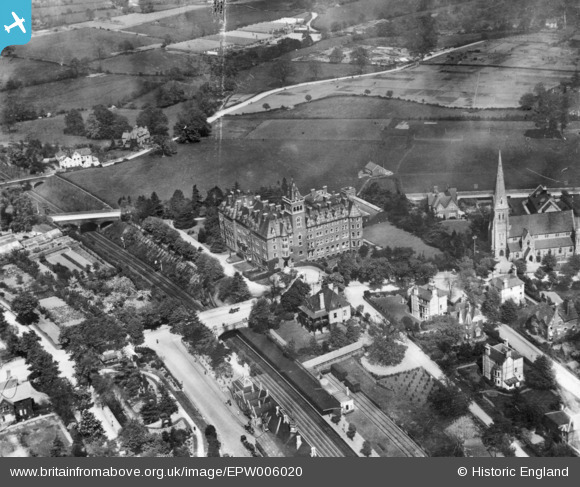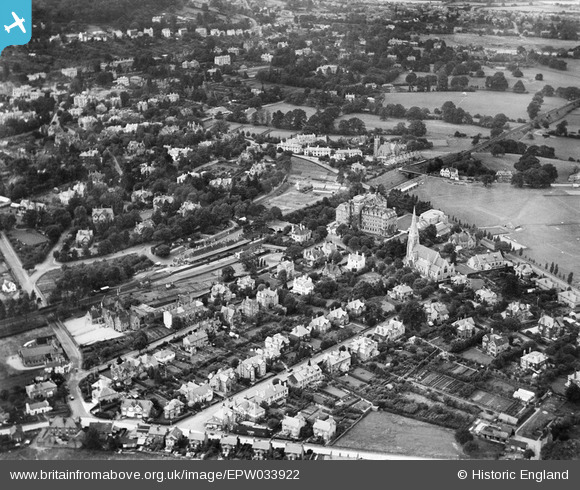6916 'Misterton
Hall' at Great Malvern, date unknown.
 |
| The original signal box sign at Malvern Museum. |
#5: The 'Worm'
'The Worm' was a corrugated metal tunnel designed to allow first-class passengers arriving in Malvern to access the hotel without having to leave cover (or to mingle with their second-class counterparts!). The tunnel is sadly neglected today, with both ends locked to prevent access to what is now a school. There are plans to see the feature restored, however.
 |
| The locked door to 'The Worm'. |
 |
| Here we see the Worm on the right and the hotel's service door behind. |
Pigeon Trains
The next shot is of a 'pigeon train' waiting in the Midland Bay at Great Malvern.
Jon Pratty recalls:
'The pigeon train was usually a diesel multiple unit or a loco with parcel vans carrying hundreds of pigeons in baskets. These were racing pigeons from all over the Midlands, sent by their owners by rail, to be released a distance away. The pigeons would then fly back home, getting valuable racing practice. It's amazing, but this was a regular weekly event. I don't know if the pigeon fanciers sent their racing pigeons elsewhere - they must have done - but Malvern was a regular destination. British Rail charged to carry the baskets with ten or fifteen pigeons in each one. The baskets were gathered together in groups by region then sent here on one train. When the train pulled in, station staff and us trainspotters would unload the baskets onto luggage trolleys, then line the trolleys up on the platform edge. Then we'd unbuckle the baskets and let out the racing birds in one big feathery cloud. Great fun! I have no idea when this stopped.'
 |
| 3738 on the Wolverhampton - Great Malvern pigeons trains, recessing while the birds were released. |
Pigeon trains were not the only services bringing animals to Great Malvern, and the station was also used to ferry livestock to the Three Counties Showground on Hanley Road. Richard Moreton writes:
'These were taken on 16th June 1961, when a train of Southern region horseboxes, coach and well wagon with a carriage were unloaded at Great Malvern, all in connection with the Three Counties Show. This was the only occasion when I saw the end-loading dock on the down side in use (although I believe that in the mid-1950s when Sanger's Circus came to town the elephants got off there). At that time, it was possible to walk from the down-side exit along an unsurfaced extension of Thorngrove Road, turning left by Imperial Garage and coming out in Manby Road. There was a gate for vehicles unloaded from the loading dock to exit via this unsurfaced road. I suppose in the days of the water-cure this could have been a regular occurence.
The bay platform, after the closure of the Ashchurch line, was used for a variety of trains... the pigeon train, the school baggage train, and from 1959-61, a local Worcester-Ledbury train recessed there in the afternoon for an hour or so. I used to catch it to get home from school, as the Paddington train ran non-stop from Great Malvern to Hereford, and I needed to retrieve my bike from Malvern Wells station.'
 |
| Southern Region horseboxes in the Midland bay platform, June 1961. |
 |
| Southern Region horseboxes on the up line at Great Malvern, June 1961. |
 |
| Southern Region horseboxes departing southwards, June 1961. |
The Imperial Hotel
This shot was taken in the 1870s, and shows the Imperial hotel on Avenue Road in its freshly-built state. The railway embankment has just been planted and the hotel sits alone on what would then have been the edge of Great Malvern. A couple of noteworthy railway-related features stick out, the first of which is the large wooden door sitting perpendicular to the track: this was attached to a small turntable which allowed coal trucks to be rotated ninety degrees and pulled directly into the hotel's cellar. The second is the corrugated iron tunnel leading up to the hotel: known as 'The Worm', this allowed first-class passengers coming into Malvern to alight on Platform 2 and walk straight into the hotel without going outside.
 |
| The Imperial Hotel during the 1870s. Used by kind permission of Keith Smith. |
Fast-forward 140 years, and not too much has changed. The Imperial Hotel was taken over by Malvern Girls' College (since 2006 Malvern St James') in 1919 and has been in use as an independent school ever since. Architecturally, the front of the hotel has been widened with an additional wing, which now blocks the view of the offset staircase windows seen in the 1870s shot. The pointed roof has also been dismantled and replaced with a flat-top tower and flag pole. The tall trees and overgrowth make it tricky to see, but the coal door is still present but now defunct, while The Worm too is now somewhat delapidated, being unusable for its original purpose.
 |
| Malvern St James' School today. |
 |
| The former Imperial Hotel from Avenue Road. Note the extra wing on the left. |
Rowallan House
Sitting on the slope above Great Malvern station is Rowallan, a house often recorded as being the former Station Master's residence. Now divided into several flats, the house is nonetheless mostly untouched on the outside, and overlooks both the station and the former Imperial Hotel across Avenue Road.
 |
| Rowallan House from Avenue Road. |
Importantly, however, Rowallan's history has been much debated, with some local historians arguing that the Station Master may never have lived there at all. The following text has been reproduced from an article that Cora Weaver wrote for the Malvern Museum newsletter in May 2011. I would like to thank both Cora for her permission to show her work here, and also Faith Renger at Malvern Museum for mentioning this research to me recently. If anyone has any further insights into the history of the house I'm sure we would all be interested to hear about it - many of the railway books I have read have taken it at face value that Rowallan was the Station Master's residence, but perhaps this is the result of authors reading eachother's works and taking what they read as fact. In any case, here is Cora's research:
"For years people have said that Rowallan, an imposing, detached house in Avenue Road, next to the railway station, was built for the station master. So many people have said this that surely it must be true. But where was the evidence? Great Malvern was a small provincial station and the station master was an employee. Employees didn't live in grand houses like Rowallan! So my quest was to discover who did live at Rowallan, and where the station master really lived.
Directories are a useful guide to sorting out the upper classes from the middling and lower classes. The upper class were listed in Directories under 'Private Residents', and only private residents lived at Rowallan. In 1867, shortly after the house was built, the occupant was Richard Reader Harris Esq. The 1871 census shows 50-year-old brewer William Colman, his family, and four servants there, and for many years after that, Mrs Georgina Colt, widow of barrister George Colt, lived there with her family and servants.
The earliest mention I could find of Great Malvern's station master was in an 1868 Directory. Theodore Allen Berrow Cliffe was not a Private Resident. His previous job had been as a railway guard. The 1871 census shows him as aged 41 and living at number 5, Imperial Terrace, Manby Road, with his 23 -year-old wife Rosina and their three children aged 3, 2 and 1. Sharing the house with them was a general servant and two lodgers, both barmaids. Their neighbours were lodging house keepers and cabmen, which suggests that Mrs Cliffe took in lodgers to supplement her husband's wages. The 1871 census also shows 22-year-old railway clerk Thomas Richard Franklin lodging with a straw bonnet maker in Stourport .
By 1879 T.A.B Cliffe had died and T.R Franklin had become Great Malvern's station master. He and his wife Patience, daughter of well-known local grocer James Nott, and their one-year-old daughter, were living at 37 Lansdowne Crescent with a servant and three respectable lodgers. The house has been demolished, but it was probably one in a short terrace of three or four. By 1901 Thomas and Patience, their two children, two servants and five respectable lodgers were at Hatfield, a semi-detached house in Priory Road. It was a modest house compared with the magnificent mansions that littered the rest of the road.
Generally in the past, one's status was determined by one's class, and one's class determined where one lived. This brief investigation confirms that Rowallan was not built for the station master, and the station master never lived there. It also confirms that you should never believe everything people tell you....."
Sources:
Picture of Imperial Hotel: Keith Smith, Around Malvern (Chalford, 1995), p. 36.
|






































I have a small cutting from a 1923 GWR staff magazine about my great grandfather who retired at year after 47 years as a GWR signalman at Great Malvern. I also have a group photograph of the station staff, taken by the signal box. It’s undated but I would think it must be from about 1900.
ReplyDeleteMy Great Grandfather was Station Master. I dont know his name - only that my Grandmother was Ellen Bennet who married Evan/Emrys Davies a Miner from Bargoed South Wales. They had 3 sons William, Kenneth and Emrys Derek. My father was the middle Kenneth. Evan died when he was only a small boy and Ellen as a penniless widow worked very hard to keep them out of the workhouse. The 3 brothers spent their whole lives together with their wives and were successful business men - although they wouldnt like me saying that! I am the only one of the next generation but have 4 children of my own. I would love to know more about my family history.
ReplyDeleteContinued from above: My dad, Kenneth, was born in 1919
ReplyDelete